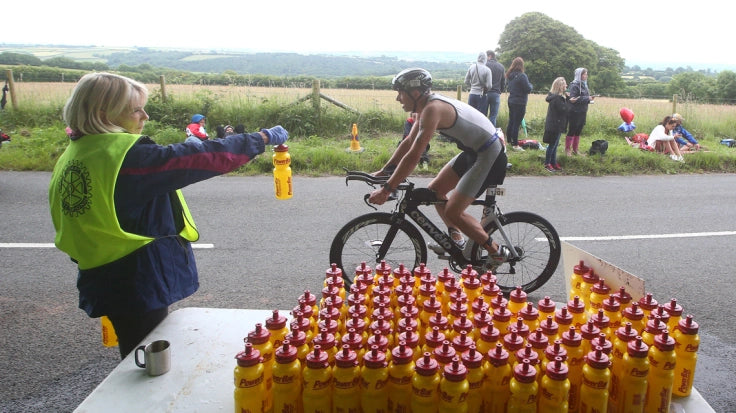
The hyponatremia story
Many athletes know how important hydration is to their performance, but drinking too much water can lead to problems. One such problem is hyponatremia , where the sodium level in your blood becomes too low because you have drunk too much water without replacing enough electrolytes like sodium. This can lead to symptoms like nausea, fatigue, headaches, and in extreme cases, even serious health problems. While hydration is important, it is essential to find the right balance of fluids and electrolytes, especially during long workouts.
What exactly is hyponatremia?
Hyponatremia occurs when you drink too much water without replacing sodium. Sodium is an electrolyte that is crucial for regulating fluid balance, nerve function, and muscle contractions in your body. When you sweat a lot and only drink water, you dilute the sodium in your body. This can seriously affect your performance and can even be dangerous if your body doesn’t have time to recover.
In a study of ultramarathon runners participating in the 246 km Spartathlon, 14% of the runners were already found to have a form of mild hyponatremia at the start. This shows how easily it can happen, even in well-trained athletes. Hyponatremia is a risk that many athletes underestimate, especially in long-distance events such as ultra running, triathlons and marathons.
How do you prevent hyponatremia?
A common technique to prevent this is sodium preloading . This involves drinking an electrolyte drink that is rich in sodium before a long workout. This ensures that your fluid balance and electrolytes are up to par before you begin a hard workout. It is essentially the same as carb loading, but for your electrolytes. Sodium preloading can prevent your sodium levels from dropping too low, especially during long events where you sweat a lot.
Scientific studies have shown that preloading with sodium helps your body retain water better and maintains your blood volume. This reduces the workload on your cardiovascular system, which is important during long races. At the same time, it’s important to find the right balance—too much sodium can lead to stomach issues. You’ll need to experiment to find what works best for your body.
Practical tips for preloading
Here are some sodium preloading tips that you can implement during your training and race preparation:
-
The night before the race : Drink an electrolyte drink with a 300-600 mg concentration of sodium with your evening meal. This will ensure that your body is well hydrated when you wake up the next morning.
-
Race morning : Drink another 500ml of the same electrolyte drink, but make sure you drink it at least 45 minutes before the start. This gives your body time to absorb the sodium.
-
Adapt your approach to the weather conditions : Preloading is especially important if you know that the race will be hot, or if you are going to do a long effort where you will sweat a lot. In these conditions, you lose more fluid and electrolytes, which increases the risk of hyponatremia.
-
Drink Moderately During the Race : There is no need to drink continuously during the race if you have preloaded sufficiently. The goal is to maintain your sodium and fluid balance without drinking excessively.
Why is sodium so important for athletes?
Sodium helps your body retain water and plays a key role in the functioning of your muscles and nerves. During prolonged exercise, especially in hot conditions, you lose sodium through sweat. If you don’t replenish it, your sodium levels will drop and you’ll get into trouble. Many athletes think that hydration is just about drinking water, but without the right amount of sodium, this can be counterproductive.
In a scientific study of sodium loss in athletes, those who regularly preloaded with sodium were less likely to become dehydrated and performed better. This is because sodium helps maintain your blood volume, which is essential for maintaining good blood flow and oxygen supply to your muscles during exercise.
How much sodium do you need?
Not everyone needs the same amount of sodium. It depends on how long you exercise, the temperature, and how much you sweat. If you exercise in a hot climate or sweat a lot, you will probably need more sodium than someone who exercises in a cooler environment.
A good rule of thumb is to start with an electrolyte drink that contains about 300-600 mg of sodium per liter per hour . This should be enough to keep your sodium levels up during long races or intense workouts. It’s important to experiment with different amounts during your workouts to see what works best for your body.
Lessons from practice
The benefits of sodium preloading are clear: you prevent dehydration, maintain your sodium levels, and improve your performance. Athletes who use this technique, such as ultrarunners and triathletes, find that they experience less muscle cramps and fatigue during long efforts. It’s a simple but effective way to ensure that you’re well-hydrated at the start line and that your body is ready for the challenge ahead.
Preventing hyponatremia isn’t just a matter of drinking more water; it’s about finding the right balance of fluids and electrolytes. Incorporating sodium preloading into your routine will help ensure you stay hydrated without compromising your sodium levels.
Conclusion: The balance between hydration and electrolytes
The bottom line is that hydration during exercise is much more than just drinking water. Your body needs electrolytes like sodium to function properly, especially during long efforts where you sweat a lot. Sodium preloading can help ensure that you are well hydrated at the start line without the risk of hyponatremia. This is especially important in hot, humid conditions or when you know you are going to be running a long distance.
In addition to drinking water, make sure you replenish your electrolytes to keep your body in balance. This will not only prevent issues like hyponatremia, but can also improve your performance and help you reach your goals during races or training.
In short, sodium preloading is a simple but effective strategy to maximize your performance and prevent problems such as dehydration and hyponatremia. Incorporate it into your racing and training routine and experience the difference it can make!
